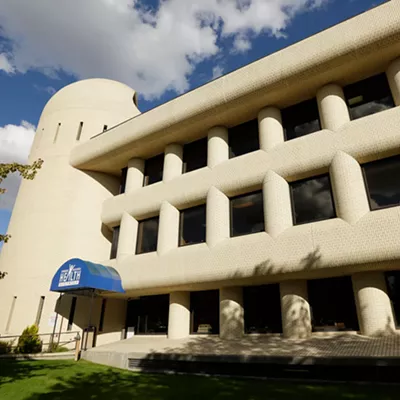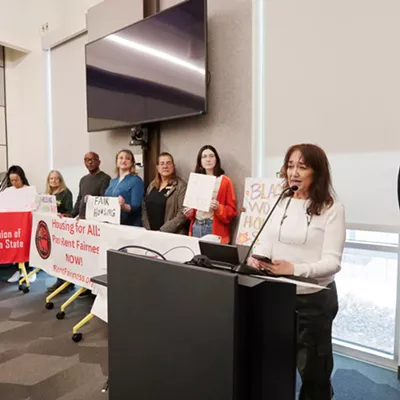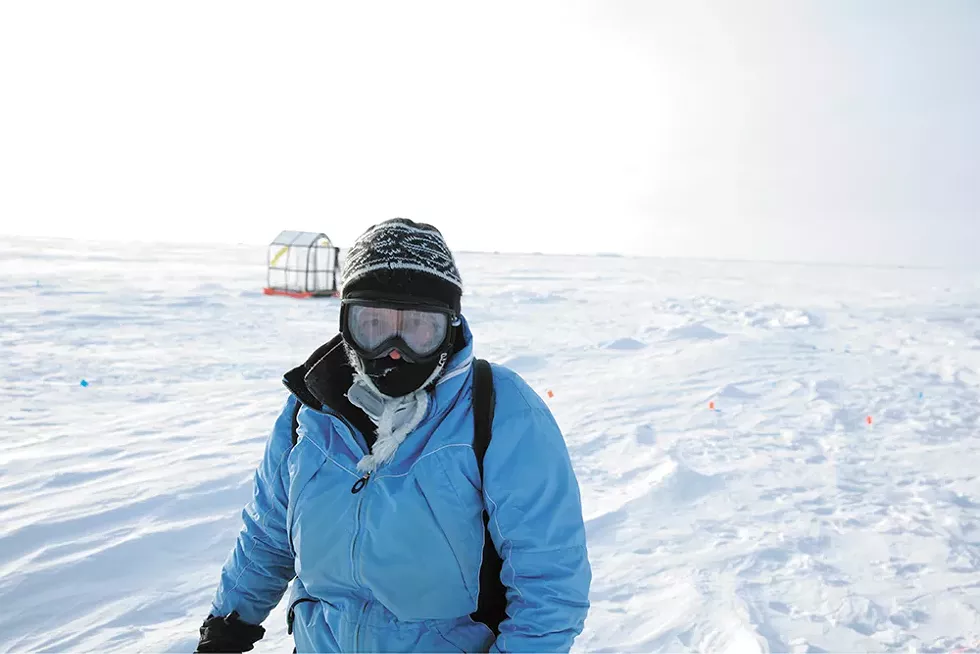
At a time when it seems more likely than ever the planet is careening toward certain devastation, it's the scientists, the inventors, the innovators who refuse to just sit back and watch it all burn. Climate activists have been gaining traction in their fight to get people to understand the urgency of addressing climate change. But truly tackling the "how" takes the inventor bundling up in her parka each year to study ice-saving technology in the arctic, the bespectacled North Idaho engineer tinkering away to create solar panels you can drive on, and the best and brightest thinkers putting their wildest ideas through rigorous computer modeling to ask "what if we did that?"
Here are 17 of their innovative ideas that just might help us save the planet.
1. SAVE THE ICE
It's been well over a decade since Al Gore's An Inconvenient Truth showed many viewers for the first time just how dire the consequences of global warming would be in their lifetimes, with ice sheets melting at an accelerated rate, severe storms likely to happen more often, and heating and cooling around the planet gone haywire.
For scientist Leslie Field, an inventor and electrical engineer, watching that movie when her kids were just 6 and 10 really put things in perspective.
"I've always been environmentally minded, but to see a movie that made it so clear how bad the consequences could be within my kids' lifetimes living here in California was like, 'Wow,'" Field tells the Inlander by phone. "I hadn't realized the extent to which it was going to affect my own family."
Luckily, her then-new job at Stanford allowed her access to some of the best environmental minds around. She learned many people were focusing on solar technology, so instead she dove into fixing another problem: saving the ice.
See, in addition to affecting sea levels, the ice sheets on our planet's poles act as reflective blankets, bouncing a lot of the sun's heat back into space. Without the ice, warming will get far worse, far faster.
For more than a decade, Field has been exploring how to save that ice in the least-damaging way possible.
Her team, Ice911, is currently studying how nontoxic silica microspheres — currently used in things like vitamins, insulation and medical applications — can help reflect the sun's heat, allowing ice sheets to grow thicker and last longer. The material, which looks like a white powder, floats on water, and so far doesn't have any apparent detrimental effects to wildlife or the ecosystem.
"I'm absolutely uninterested in doing something that's going to do more harm," Field says. "We're working with the least amount of intervention, as natural as possible, and we want to make sure it's localized and reversible. With those principles, I'm really comfortable with this material."
Ice911 is currently testing on a lake in Utqiagvik (formerly Barrow), Alaska, the northernmost point in America. Between that and testing conducted in Minnesota, the team is hopeful they've shown the material is effective and affordable.
"Think about $1 billion to $5 billion per year to do an at-scale deployment," says Field, referring to the amount needed to cover a targeted 100,000 square kilometers of the Arctic, "and then you compare that to the cost of just one climate devastation-type disaster, like last year was something like $400 billion from the California wildfires."
Field says she's inspired by the results her team is seeing and the work of other scientists trying to tackle climate change problems as fast as possible.
"People are working so hard in very focused ways that are showing some real impacts. There really is cause for hope and action," she says. "It's so much better than to just dwell in despair. Instead it's 'Wait, there's stuff to do!' but by all means we've got to get on it now."
2. TURN PLASTIC INTO FUEL
Despite the growing popularity of recycling, the U.S. sent 26 million tons of plastic — more than 75 percent of what was generated — to landfills in 2015, according to the Environmental Protection Agency.
But recently, Washington State University scientists have found a way to efficiently convert common plastics into needed fuels. Using a combination of products like milk bottles, plastic bags and water bottles, ground down to pieces, the team used heat and activated carbon to convert the plastics into a mix that can be separated out into jet fuel and diesel.
"We can recover almost 100 percent of the energy from the plastic we tested," says WSU associate professor Hanwu Lei in an announcement about the project. "The fuel is very good quality."

3. SEQUESTER CARBON IN SOIL
Adjusting worldwide farming through methods "such as incorporation of organic manures, cover cropping, mulching, conservation tillage, some types of agroforestry practices, rotational grazing" and other practices could significantly increase the amount of carbon stored in soils, which would help the world get closer to the Paris Agreement goals, according to a 2017 study published in Nature. In particular, North America, Europe and India present large opportunities for storing more carbon in soil, according to the paper, "Global Sequestration Potential of Increased Organic Carbon in Cropland Soils."
4. HUMAN COMPOSTING
Making caskets, filling bodies with embalming fluids, and even reducing a body to ashes using natural gas all comes with a carbon footprint and environmental impacts. Now there's another option in Washington, the first state to allow human composting. The composting process speeds up natural decomposition and is expected to save a metric ton of carbon dioxide emissions per person who opts in, according to the organization Recompose, which fought for the law.
5. CONVERT METHANE TO CARBON DIOXIDE
Stanford researchers acknowledge their newly announced technology for addressing climate change might be counterintuitive: It actually involves the creation of carbon dioxide. But the key is they're taking methane, which is 84 times more potent of a greenhouse gas, and converting it into the less harmful CO2. Because people are likely to keep eating cows and growing rice, both of which produce lots of methane, it makes more sense to find ways to convert the methane into something less harmful, the Stanford researchers note.
"If perfected, this technology could return the atmosphere to pre-industrial concentrations of methane and other gases," says lead author Rob Jackson, a Stanford professor, in a May 2019 announcement.
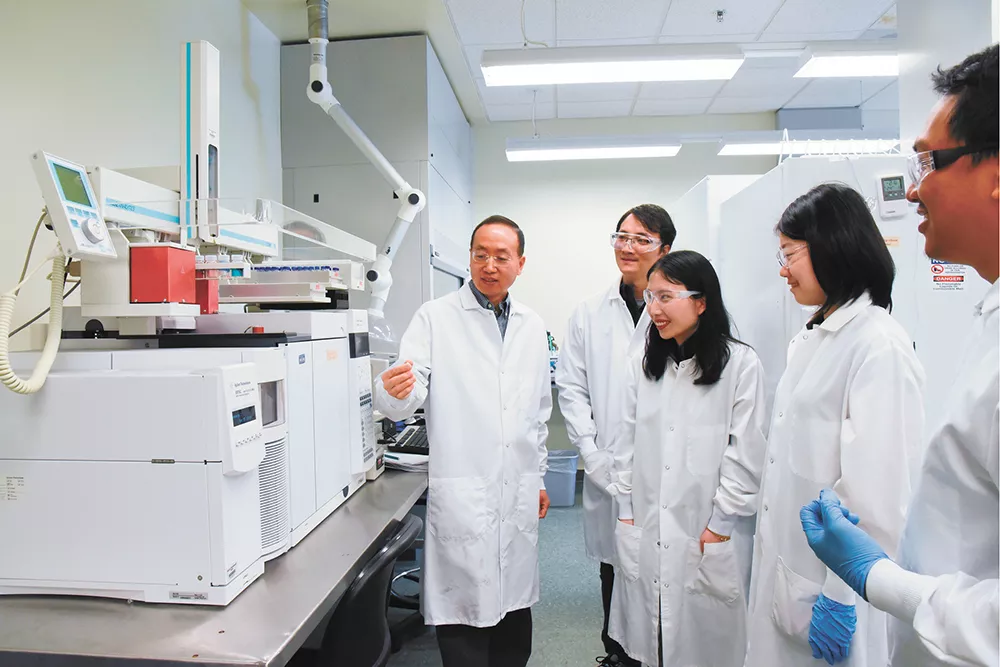
6. DITCH THE CHEMICALS
Remember when the big deal in reducing bad chemicals was telling your mom to stop using that old hairspray because aerosols were depleting the ozone layer? Well, it turns out in some cases we replaced those aerosols and other "ozone-depleting substances" with chemicals that are pretty harmful, too. Some hydrofluorocarbons (HFCs) now used in spray foams, refrigeration, air conditioning and other applications are up to 14,000 times more potent greenhouse gases than carbon dioxide. Under a Washington law passed in 2019, the use of many of those chemicals will be phased out over the next few years, and by December 2020, the state will issue a list of the best substitute chemicals with lower global warming potential.
7. HARNESS THE SUN MORE EFFICIENTLY
When you think of solar panels, the image that likely comes to mind is of the increasingly common smooth black silicon solar panels that are often installed on homes, office buildings and in large solar arrays. For the last decade or so, scientists have been working to improve solar efficiency because most panels now only convert about 15 to 18 percent of solar energy into power. Now, promising new research from the University of Oxford has shown that using a combination of silicon and crystals known as "perovskites" can increase the efficiency of solar panels up to about 28 percent. Better efficiency makes the panels more affordable and worth adopting.
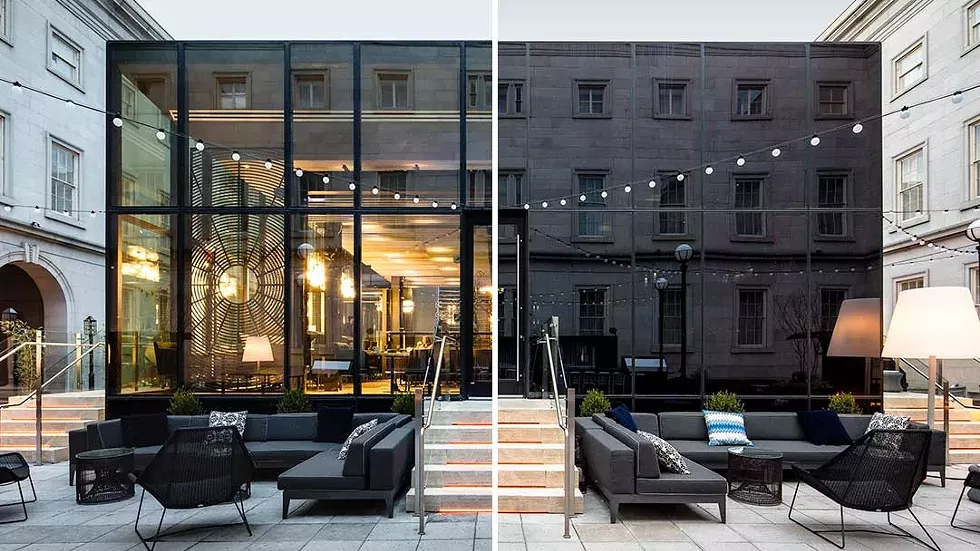
8. BUILD WITH SMART GLASS
With more buildings featuring vast glass walls, there are several new types of "smart glass" that aim to help save on cooling and heating costs in buildings suddenly flooded with light. Some smart glass windows can instantly dim and block out sunlight that would otherwise increase cooling costs, or turn transparent when it's beneficial to let more light and heat in. The technology, which frequently requires electricity to work, can be programmed to automatically adjust window tinting based on temperature, saving energy. For example, compared to transparent glass, electrochromic glass reduced the energy required for heating and cooling a model office building by 41 percent in a 2018 South Korea study.
9. USE BETTER BUILDING MATERIALS
One way to reduce the carbon footprint of concrete, which contributes 8 percent of the planet's CO2 emissions, is to incorporate carbon capture technology. California company Blue Planet essentially creates limestone rocks by sucking carbon dioxide out of the atmosphere and binding it in layers onto junk rock. Those rocks can then be used as fill in the concrete, significantly reducing the carbon footprint of projects.
Another alternative to concrete gaining popularity is Cross-Laminated Timber, or CLT. The wood product is made from gluing lots of smaller pieces of wood together to create incredibly strong beams. And the Inland Northwest is poised to lead in the CLT industry, as Katerra has opened a new factory in Spokane Valley. CLT is lauded for storing carbon, recycling wastewood, and for reducing the need for concrete in smaller multistory buildings.
10. SOLAR ROADWAYS
Imagine if every road, parking lot, sidewalk, highway, tarmac, and paved surface on the planet was able to generate electricity, eliminate the need for shoveling snow and light the way with instantly changeable LED lighting configurations.
"If every walking and driving surface in the U.S. were installed with solar road panels, it would produce three times more energy than we use."
It's an idea that went viral five years ago with an enthusiastically narrated video that let the world know about "Solar Freakin' Roadways," a clean energy idea born in Sandpoint.
The thinking is this: In the U.S., there are millions of square miles of paved surfaces, seeing as we need them for everything from walking and biking to moving around in our cars. Why not put them to better use by paving them with solar panels?
"We believe Solar Roadways implemented on a grand scale is the most viable solution to the climate crisis," Solar Roadways inventors Julie and Scott Brusaw tell the Inlander by email.
With lessons learned from a pilot installation in Sandpoint, a driveway installation at their shop, and testing performed under federal Department of Transportation grants, the fourth iteration of their prototype, the SR4, is closer to being road-ready than ever. The new panels are 50 watts, and that could get even better over time as technology improves.
"Even prior to the SR4 wattage upgrade, Scott calculated that if every walking and driving surface in the U.S. were installed with solar road panels, it would produce three times more energy than we use," Julie writes. "We'll continue to use more efficient solar cells as that industry moves forward, so those numbers will continue to get even better."
The hexagonal panels not only produce electricity, but contain heating elements and LED lighting that enables road lines to be changed in an instant. The road could light up to warn drivers an animal is in their way up ahead, and with heating, the panels won't need plowing or shoveling in the snow.
Now Scott is working to further engineer the panels to include dynamic charging, which could allow electric vehicles to charge on the road while driving.

While they're still in the early stages and working on a second pilot installation across the country this fall, the couple says that the Inland Northwest is expected to be among the first places to see adoption of the new technology.
"We've always planned that roads will be our last application. We are perhaps two to three years away from being ready for roads. First, we'll focus on driveways, sidewalks, parking lots, etc.," the couple writes. "But highways will be our final goal. The city of Sandpoint says it would like to be the home of many more firsts. We also have interested customers in Coeur d'Alene, Spokane and many other nearby cities."
11. MAKE PLANTS TASTE LIKE MEAT
By this point, you've probably heard of at least one of the companies marketing plant-based burgers meant to taste as good as the real thing. Whether it's the Beyond Burger, the Impossible Burger, or another plant-based patty, the common theme is that food scientists are doing their best to make plants taste, and in some cases even feel, like meat, in the hopes that more meat eaters will make the switch to veggies. Meat production accounts for a massive portion of our global emissions: A 2018 study published in Science magazine found that for the U.S. in particular, switching from a meat-based diet to a plant-based one could reduce greenhouse gas emissions from our food by up to 73 percent. That's pretty major, considering the overall food system accounts for about a quarter of emissions.
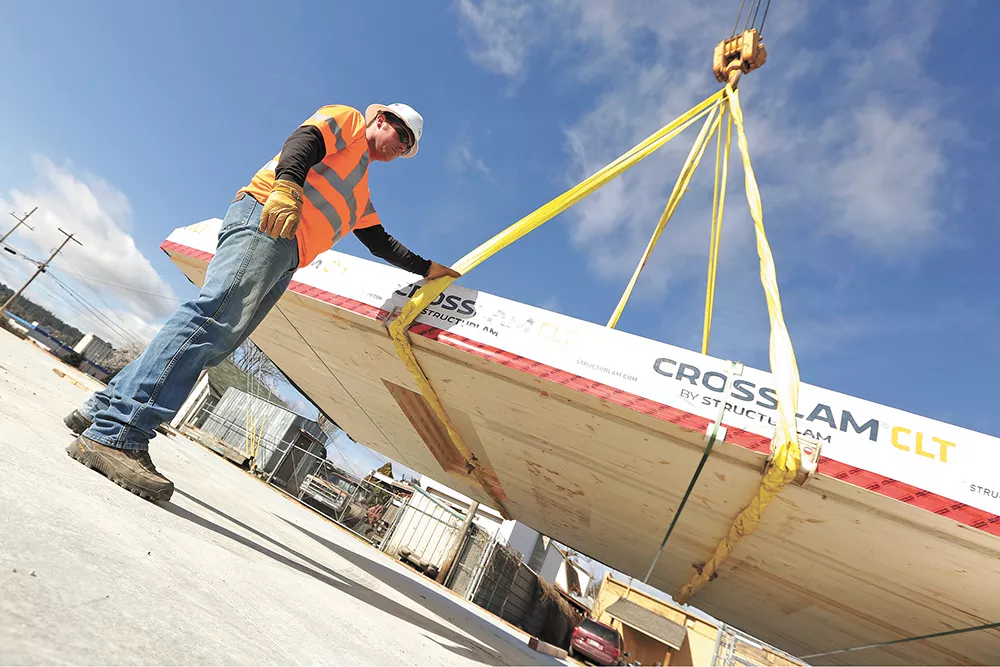
12. HIT 100 PERCENT CLEAN ENERGY BY MIDCENTURY
In order to truly limit warming to less than 2 degrees celsius above pre industrial levels, all power plants around the world need to transition to clean energy by midcentury, according to a study published in Nature this month. Without sunsetting power plants that currently use fossil fuels, those plants will use up the rest of the planet's carbon budget. The urgency of those calculations has led states like Washington and even private utilities in Idaho to declare they will be 100 percent carbon-neutral by 2030 and use completely clean energy (with no purchase of offsets) by 2045.
13. EDUCATE GIRLS
What does education have to do with climate change? It turns out, a lot. Education of girls in particular plays a huge role in providing reproductive justice and decreasing a country's overall poverty. Girls with more education tend to lead healthier lives and have fewer children, which is one of the biggest ways to reduce impacts on the planet. That's why Project Drawdown, a research collaboration that ranked 100 of the top climate change solutions, places education of girls near the top of its list. The Brookings Institution think tank also notes that less educated girls are more likely to be disproportionately impacted by climate change events. Ensuring girls have more education not only makes their country more resilient to climate change, but it also helps set them on a path to become particularly effective conservation leaders, Brookings notes.
14. PLANT 1 TRILLION TREES
Splashy headlines this summer pointed out that planting trees could be the best way to fight carbon dioxide pollution. That's because the recent study, "The Global Tree Restoration Potential," published in Science, called reforestation on the scale of planting 1 trillion trees the "most effective climate change solution to date." But it's not quite that simple. As the researchers note, because of the changing climate, it might not be possible to actually plant that many trees and have them survive in changing ecosystems unless immediate action is taken.
"We estimate that if we cannot deviate from the current trajectory, the global potential canopy cover may shrink by about 223 million hectares by 2050, with the vast majority of losses occurring in the tropics," the researchers note. "Our results highlight the opportunity of climate change mitigation through global tree restoration but also the urgent need for action."
15. CAPTURE CARBON TO MAKE GASOLINE
Just north of the Washington border in Squamish, British Columbia, a private company partly funded by Bill Gates has spent the last few years pulling carbon dioxide from the air and converting it into usable fuel. The company, Carbon Engineering, is working on its low-carbon or carbon-neutral fuel along with underground storage that can be used for the indefinite capture of carbon from the atmosphere.
Their work has Canada and private investors excited: The government just invested $25 million Canadian into the company, and private investors put in $91 million Canadian in a recent investment round, according to a June company press release.
"We would like people to be recycling their fuel in the same way as they recycle other things," Carbon Engineering CEO Steve Oldham told VICE in September.
He explains the real innovation is that, unlike a switch to electric vehicles, which globally would be extremely expensive and require massive changes in infrastructure, pulling carbon from the atmosphere to make gasoline or diesel allows for an instantly cleaner transportation system.
"That car you just drove up in, we can make that carbon-neutral tomorrow," Oldham continues telling VICE. "Any performance vehicle, any battered old truck, airplanes, we're compatible with all of those, which is significant because nobody's making any electric tractors or electric planes."
16. SEA WALLS TO PROTECT GLACIERS
Glaciers in Greenland and Antarctica are melting at unprecedented rates, and once they hit a breaking point, they're expected to completely collapse and never return, contributing to sea-level rise and overall warming. But what if you could somehow keep warm ocean water far enough away from the most important glaciers, saving them from reaching that collapse point? That's the subject of research published by Michael Wolovick and others in the journal The Cryosphere in 2018.
Their study used modeling to see what might be achievable, and for now, it kind of amounts to "so you're saying there's a chance."
"The easiest design that we considered would be comparable to the largest civil engineering projects that humanity has ever attempted, it would be located in a much harsher environment than the ones in which those projects were built, and our results suggest that it would only have a 30 percent probability of success," the researchers note in their paper.
That's why they'd advocate a long-term approach in exploring wall construction, improving technology to the point where such an undertaking would be more feasible and more likely to succeed.
17. THINK SMALL
As utilities and environmentally minded developers plan to test the best ways to switch between wind, solar and battery storage in a new clean-energy world, they're also thinking about how buildings and developments can better share electricity and heating with each other. Two of the main concepts that are gaining traction are microgrids and district heating. With a microgrid, a neighborhood or development with its own solar panels and other power generation can be fully in control of its power without interfering with the overall electric grid that we're used to. However, it would still be possible to create tie-ins where those buildings could draw power from the grid when needed. For district heating, a single source — say a furnace burning the biomass leftover from a nearby mill — can provide heat throughout an entire area, eliminating the need for unique furnaces in every unit. Avista will be testing similar ideas and methods in a new eco-district in Spokane anchored by the Catalyst Building, which is designed to be the smartest building in North America when it is finished some time next year. ♦
Samantha Wohlfeil covers the environment, rural communities and cultural issues fo the Inlander. Since joining the paper in 2017, she's reported how the weeks after getting out of prison can be deadly, how some terminally ill Eastern Washington patients have struggled to access lethal medication, and how people are working to address climate change. She can be reached samathaw@inlander.com or 325-0634 ext. 234.







